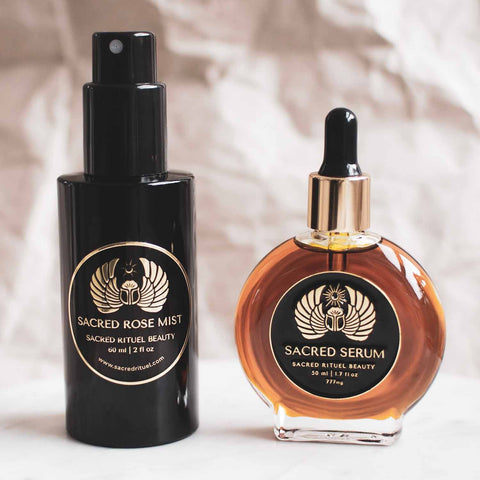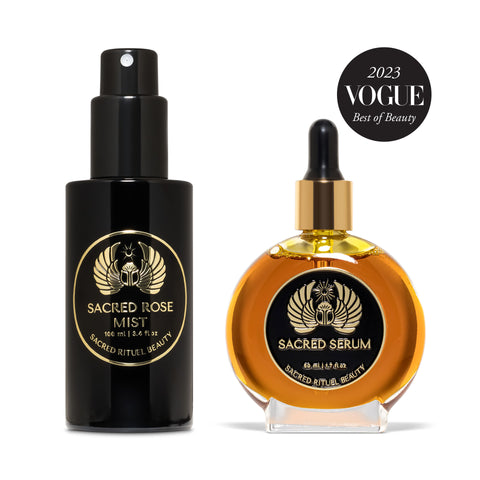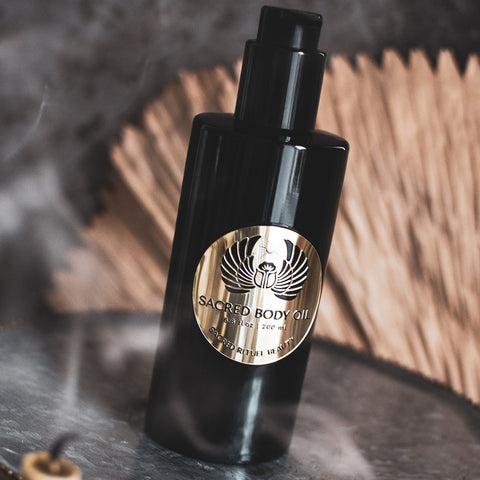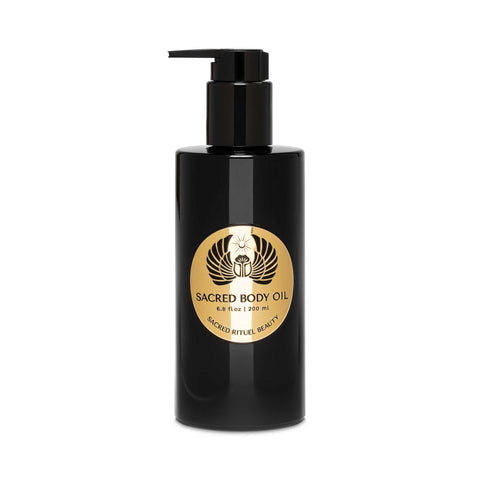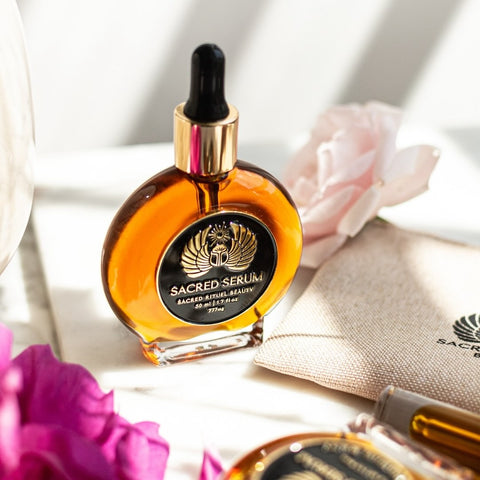Effective Treatments for Melasma and Dark Patches
As a skincare brand rooted in organic and natural solutions, Sacred Rituel aims to help women feel confident and beautiful with products that soothe and heal the skin. Our expertise in combining nature’s best ingredients with modern skincare helps us offer safe and effective treatments for melasma and other dark spots.
Products formulated with Green Tea to address inflammation and oxidative stress.

Key Takeaways:
- Understanding Melasma: Melasma causes dark patches on the face and is often triggered by hormones, sun exposure, and genetics, but it can be managed with the right care.
- Treating and Preventing Melasma: Cold-pressed oils and skincare routines can help fade dark spots, while daily sunscreen and gentle skin care are essential for prevention.
- When to See a Doctor: If melasma worsens or doesn’t improve with home treatments, a dermatologist can provide advanced options for better results.
What Is Melasma And What Does It Look Like?
Melasma is a skin condition where dark, blotchy patches show up, usually on both sides of the face. You’ll often see it on the cheeks, forehead, nose, or upper lip, but it can sometimes appear along the jawline or neck too. The patches aren’t painful or anything, but they can be really stubborn to deal with. Depending on your skin tone, they can range from light brown to grayish-brown, and while they usually blend in with your skin, they might sometimes feel a little different.
A lot of people call it the “mask of pregnancy” because it’s super common during pregnancy thanks to hormonal changes. But it’s not just a pregnancy thing—it can happen to anyone.
Causes Of Melasma And Dark Patches On The Face
Understanding what causes melasma is the first step to managing it. While the exact reason isn’t always clear, here are some common triggers that might lead to those pesky dark patches:
Hormonal Changes
Hormones are one of the biggest drivers of melasma. During pregnancy, for example, your body produces higher levels of estrogen and progesterone, which can overstimulate the melanocytes—the cells responsible for pigment. This is why melasma is often called the “mask of pregnancy.” Similarly, starting or stopping hormonal birth control or undergoing hormone therapy can disrupt the balance, leading to the appearance of dark patches.
Sun Exposure
UV rays from the sun are a major culprit. Even a small amount of sun exposure can worsen melasma or bring it back after treatment. The sun’s rays trigger melanocytes (the cells that produce pigment) to work overtime, especially in people prone to melasma.
Genetics
If melasma runs in your family, you might inherit a predisposition for it. This means your skin may be naturally more reactive to triggers like hormonal changes or sun exposure. Think of it like a sensitivity switch that gets flipped on more easily if your genes have set the stage for melasma.
Skincare Products And Irritation
Using the wrong skincare products can irritate your skin and make melasma worse. For instance, harsh exfoliants, strong chemical peels, or certain fragrances can disrupt your skin barrier, causing inflammation that triggers pigmentation. Even waxing areas like the upper lip or cheeks can irritate sensitive skin and worsen melasma.
Stress And Lifestyle Factors
While stress doesn’t cause melasma, it can indirectly contribute by messing with your hormones. High stress levels can increase cortisol, which may throw off the delicate balance of your body’s hormonal system. Combined with poor sleep, unhealthy eating habits, or a lack of self-care, it creates a perfect storm for melasma to develop or worsen.
Does Melasma Go Away On Its Own?
The answer isn’t straightforward—it depends on the individual and what’s causing the melasma. In some cases, melasma can fade on its own, especially if the trigger is temporary. For example:
- Pregnancy-Related Melasma: This type of melasma often fades a few months after childbirth when hormone levels return to normal.
- Medication-Induced Melasma: If a medication causes your melasma, it may lighten or disappear after stopping the medication (with your doctor’s guidance, of course!).
However, for many people, melasma doesn’t go away completely without treatment, especially if it’s caused by long-term factors like sun exposure or genetics. Even with treatment, melasma can be persistent and may come back if triggers like UV exposure or hormonal changes occur.
The good news is that there are effective ways to manage and reduce melasma, even if it doesn’t vanish entirely. With consistent care, you can fade those patches and keep them from worsening.
The Role Of Cold-Pressed Oils In Managing Melasma And Dark Patches
Cold-pressed oils have been gaining popularity for their natural, skin-nourishing properties, and some of them can be quite effective in managing melasma. Here’s how they can help:
Rich In Nutrients For Skin Repair
Cold-pressed oils are extracted without heat, preserving their powerful nutrients like vitamins A, C, and E. These vitamins are essential for skin repair, as they help to heal damaged skin cells and promote a more even complexion. For example, rosehip oil is rich in vitamin A (retinol), which encourages cell turnover, fading dark patches over time.
Anti-Inflammatory Properties
Many melasma cases are worsened by skin irritation or inflammation, and cold-pressed oils can help calm things down. Oils like rosehip and chamomile contain natural anti-inflammatory compounds that soothe redness and reduce the risk of pigmentation flare-ups. By calming the skin, these oils create an environment for healing and make your other treatments more effective.
Hydration Boost Without Clogging Pores
Keeping your skin hydrated is crucial because dryness can make dark patches look more pronounced. Cold-pressed oils like jojoba and squalane provide lightweight hydration that penetrates deeply without blocking your pores. Hydrated skin is more radiant and better equipped to resist further pigmentation caused by external damage.
Gentle Brightening Effect
Some oils, such as almond and turmeric, contain natural compounds that can gradually lighten hyperpigmentation. For instance, almond oil is rich in niacin (a form of vitamin B3), which is known for brightening dark spots and improving uneven skin tone. With regular application, these oils can give your skin a soft glow while reducing the visibility of dark patches.
Safe For Long-Term Use
Unlike chemical treatments that can irritate the skin with prolonged use, cold-pressed oils are gentle and well-tolerated over time. They’re especially great for people with sensitive skin or those looking for a natural alternative to harsher products. When paired with daily sunscreen and a solid skincare routine, these oils become a valuable tool for maintaining healthier, more balanced skin.
Brighten Up: A Natural Solution For Melasma With Sacred Serum
At Sacred Rituel, we believe in empowering you with gentle, natural solutions that work. Our Sacred Serum is designed to nourish, heal, and balance your skin, making it an ideal addition to your routine if you're tackling melasma. Here’s how Sacred Serum can help:
- Fades Dark Spots Naturally: Packed with antioxidants like Vitamin E (Tocotrienol) and cold-pressed botanical oils, Sacred Serum helps brighten and even out your skin tone over time.
- Soothes Inflammation: Our USA-grown organic hemp extract is a powerful anti-inflammatory that calms irritation and reduces redness, preventing triggers for melasma patches.
- Protects Against Sun Damage: With SPF 10 UVA + UVB protection, Sacred Serum shields your skin from the sun—a common cause of melasma flare-ups.
- Hydrates & Nourishes: Lightweight and deeply moisturizing, it balances oil production and ensures your skin stays hydrated without feeling greasy.
- Gentle for Sensitive Skin: Sacred Serum is 100% organic, free from harsh chemicals, and enriched with cold-pressed oils that retain their vital nutrients for a soothing experience.
Melasma doesn’t have to define your skin. Take the first step toward healthier, more even-toned skin today!
When Should You See A Doctor?
While home remedies and over-the-counter treatments can help manage melasma, there are times when it’s a good idea to consult a dermatologist. Here’s when you should consider making that appointment:
Your Melasma Is Getting Worse
If you notice your dark patches spreading or turning darker despite using treatments, it’s time to consult a professional. Melasma can sometimes become more severe due to underlying triggers like hormones or sun exposure that need targeted intervention. A dermatologist can evaluate the condition and prescribe treatments to control further pigmentation.
You’re Unsure About The Diagnosis
Melasma isn’t the only condition that causes dark patches on the skin, so it’s important to confirm the diagnosis. Other conditions like post-inflammatory hyperpigmentation or age spots can look similar but require different approaches to treatment. A dermatologist can carefully examine your skin and may use tools like a Wood’s lamp to differentiate between conditions and create a customized treatment plan.
Over-the-Counter Treatments Aren’t Helping
If you’ve been diligently applying over-the-counter creams or natural remedies for several months without any visible improvement, it might be time to take the next step. Some cases of melasma are more stubborn and need prescription-strength solutions to break down the pigmentation effectively. A dermatologist can also combine topical treatments with professional procedures for better and faster results.
Tips To Prevent Melasma And Dark Spots
Prevention is key when it comes to managing melasma and keeping dark patches from getting worse. Here are some practical tips to help you stay one step ahead:
Wear Sunscreen Every Day
Sunscreen is your best defense against melasma, so make it a daily habit, even if you’re indoors or it’s cloudy. UV rays can penetrate windows and worsen pigmentation, so a broad-spectrum SPF 30 or higher is non-negotiable. Look for sunscreens with physical blockers like zinc oxide or titanium dioxide for better protection, and reapply every two hours if you’re sweating or spending time outside.
Seek Shade And Use Protective Gear
Sun avoidance doesn’t mean staying indoors all the time—just be smart about your exposure. Seek shade when the sun is strongest (between 10 a.m. and 4 p.m.) and wear protective clothing like a wide-brimmed hat and sunglasses. If you’re planning a beach day or outdoor event, consider using a UV-blocking umbrella or wearing sun-protective fabric to keep your skin covered.
Be Gentle With Your Skin
Your skin is already sensitive when dealing with melasma, so harsh products or over-exfoliation can do more harm than good. Opt for gentle, fragrance-free cleansers and avoid abrasive scrubs that can irritate and worsen pigmentation. Pat your skin dry with a soft towel instead of rubbing it, and always follow up with a moisturizer to keep your skin barrier healthy.
Choose Non-Irritating Hair Removal Methods
Waxing, especially on your face, can irritate the skin and trigger inflammation, which can worsen dark patches. Instead, try gentler methods like threading, dermaplaning, or a facial razor for hair removal. Always use soothing post-treatment products, like aloe vera or chamomile gel, to calm your skin after hair removal.
Manage Hormonal Triggers
If you suspect hormonal changes are behind your melasma, consult with your doctor or gynecologist to explore options. This could mean switching birth control methods or finding ways to balance hormone levels. While you can’t always control hormonal fluctuations, stress management techniques like yoga or meditation can also help stabilize your body’s response.
Stay Consistent
Melasma is a long game—it takes patience and diligence to see results. Stick to your prevention and treatment routine, even if the patches seem to fade, as melasma can come back if you drop your guard. Track what works for your skin and adjust your routine if you notice any changes, but always give products time to show results before switching things up.
Read also:
- Addressing Hyperpigmentation For Dark Skin Types
- The Right Time To Use Toner In Your Skincare Routine
- Sun Damage: How To Tell If It's Freckles Or Age Spots And What To Do About It
Frequently Asked Questions About Melasma And Dark Patches
How can I remove melasma at home?
You can try natural remedies like cold-pressed oils, combined with over-the-counter creams containing niacinamide or vitamin C. Consistent use of sunscreen is essential to prevent further darkening.
What vitamin deficiency contributes to the development of melasma?
While melasma isn’t directly caused by vitamin deficiencies, low levels of vitamin D can contribute to skin sensitivity and pigmentation issues.
What is the best sunscreen for melasma?
The best sunscreen for melasma is a broad-spectrum, mineral-based sunscreen with SPF 30 or higher that contains zinc oxide or titanium dioxide. Look for tinted sunscreens for added protection against visible light.
What foods should you avoid with melasma?
Avoid foods that trigger inflammation or hormonal imbalances, such as processed foods, sugar, and high-glycemic carbs. Also, limit alcohol and excessive caffeine.
Why is my face getting darker for no reason?
Your face may be getting darker due to sun exposure, hormonal changes, skincare product reactions, or an underlying condition like melasma or hyperpigmentation.
How do you stop melasma from spreading?
To prevent melasma from spreading, protect your skin with sunscreen daily, avoid known triggers, and stick to a consistent skincare routine that includes anti-pigmentation products.
Which fruit is good for melasma?
Fruits rich in antioxidants and vitamins, such as oranges, papayas, and pomegranates, are beneficial for melasma as they support skin health and repair.
Why is my melasma getting darker?
Melasma can darken due to increased sun exposure, hormonal fluctuations, or using irritating skincare products. Lack of consistent treatment can also worsen it.
SACRED TRIO | SERUM + ROSE TONER + BODY OIL
Prix régulier$229.00 Prix de solde$257.00
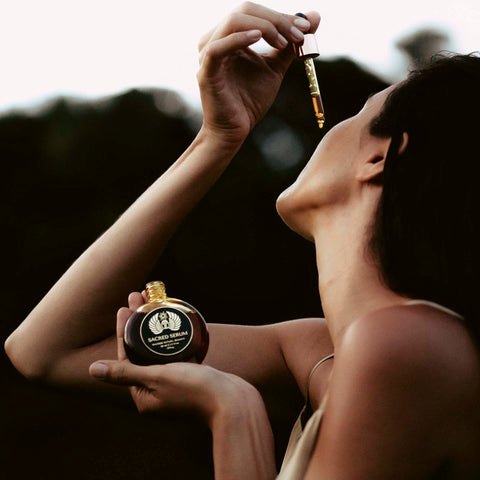
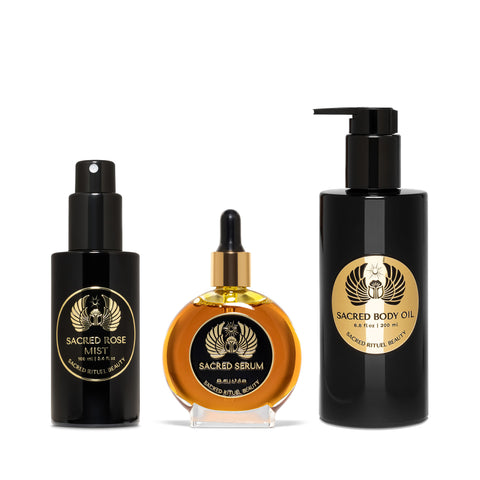


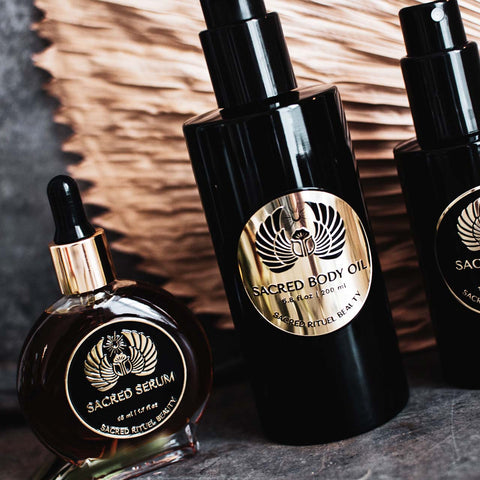

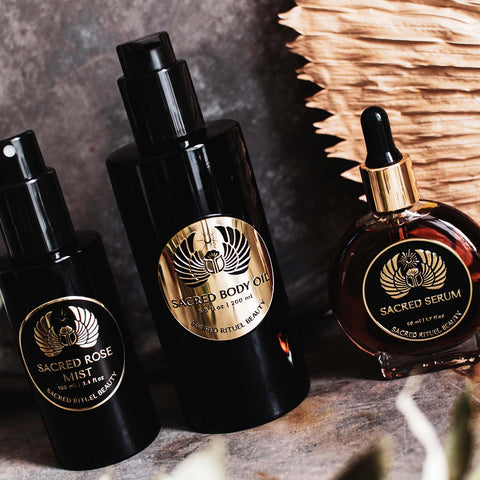

All Day Glow Essentials
Livraison express gratuite sur les commandes de plus de 100 $
Dépensez 100 $ et obtenez la livraison express GRATUITE. Dépensez 50 $ et obtenez la livraison standard GRATUITE. Livraison économique de 5 $ sur toutes les autres commandes.
Détails dans notre politique d'expédition .
Livraison automatique avec abonnement
Assurez-vous d'avoir TOUJOURS un flux constant de SACRED RITUEL à portée de main !
Détails dans notre page d'abonnements .
Retours sans tracas sous 30 jours
Essayez SACRED RITUEL pendant 30 jours et renvoyez-le pour un remboursement complet s'il ne répond pas complètement à vos attentes.
Détails dans notre politique de retour .
RITUEL SACRÉ est
Soins de la peau bio à haute puissance
Bulletin
Restez connecté sur les conseils de bien-être, les ventes exclusives et les événements !

